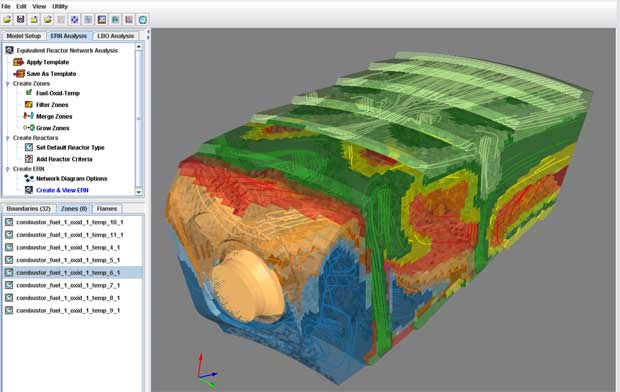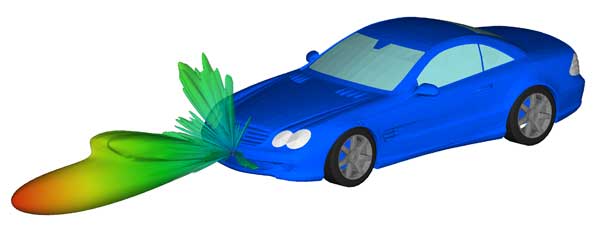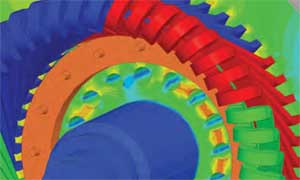Latest News
September 7, 2016
 ANSYS Chemkin-Pro supports ERNs (equivalent reactor networks) that allow simulation of real-world combustors, burners and chemical reactors, enabling efficient prediction of emissions with detailed chemistry. Here, CFD (computational fluid dynamics) results are displayed with an ERN overlay that captures the dominant flow patterns and re-circulation zones. Image courtesy of ANSYS Inc.
ANSYS Chemkin-Pro supports ERNs (equivalent reactor networks) that allow simulation of real-world combustors, burners and chemical reactors, enabling efficient prediction of emissions with detailed chemistry. Here, CFD (computational fluid dynamics) results are displayed with an ERN overlay that captures the dominant flow patterns and re-circulation zones. Image courtesy of ANSYS Inc.ANSYS Inc. has announced the 17.2 release of its portfolio of engineering simulation solutions. According to the company, ANSYS 17.2 provides users with “a wealth of new functionality” such as enhanced multiphysics coupling, new workflows for antenna design and automated temperature characteristics for electric machines. Additionally, version 17.2 enables engineers to combine advanced simulation technology across the ANSYS portfolio as well as enlist external tools to address complex engineering challenges.
Powertrain designers can use ANSYS 17.2 to better evaluate and optimize their products for fuel effects, efficiency, knocking and emissions, according to the company. To this end, the ANSYS Chemkin-Pro toolkit for simulating complex chemical reactions for combustion systems now adds plug-in compatibility with the GT-SUITE 2016 software for 0D/1D/3D multiphysics simulations from Gamma Technologies. Through Chemkin-Pro, GT-SUITE users can now gain access to detailed and validated reaction mechanisms in the ANSYS Model Fuel Library as an alternative to the standard GT-SUITE models.
For mission- and safety-critical applications in automotive, rail, aerospace and energy applications, ANSYS 17.2 provides a complete workflow from software requirements through software design and code generation to software testing and verification. In version 17.2, support has been expanded from C to Ada-certified code generation for DO-178C, IEC 61508, EN 50128 and ISO 26262 certification standards. Improved linking to IBM DOORS and Dassault Systèmes Reqtify requirements management tools enable engineers to incorporate the ANSYS SCADE suite of solutions for embedded designs into existing workflows easily, adds the company.
Also debuting with ANSYS 17.2 is a new SCADE Test environment capability to automate the testing of embedded displays and to provide enhanced support of hardware-in-the-loop (HIL) testing with VeriStand from National Instruments. Also available are AUTOSAR system design import capabilities.
 ANSYS 17.2 introduces several enhancements for antenna design and antenna placement, including a new streamlined interface between ANSYS HFSS and ANSYS HFSS SBR+ (formerly Savant) solver option. This interface, says ANSYS, enables antenna designs created in HFSS to be imported into the HFSS SBR+ solver for validating both an antenna’s design and placement. Image courtesy of ANSYS Inc.
ANSYS 17.2 introduces several enhancements for antenna design and antenna placement, including a new streamlined interface between ANSYS HFSS and ANSYS HFSS SBR+ (formerly Savant) solver option. This interface, says ANSYS, enables antenna designs created in HFSS to be imported into the HFSS SBR+ solver for validating both an antenna’s design and placement. Image courtesy of ANSYS Inc.For wireless device and IoT (Internet of Things) developers, ANSYS 17.2 delivers several enhancements for antenna design and antenna placement. Key is a new streamlined interface between the ANSYS HFSS solution for simulating 3D, full-wave electromagnetic fields and the ANSYS HFSS SBR+ (formerly Savant) solver option. HFSS SBR+ deploys the asymptotic SBR (shooting and bouncing ray) technique to predict as-installed antenna performance on platforms that are tens to thousands of wavelengths in size. ANSYS explains that this new interface enables antenna designs created in HFSS to be imported to the HFSS SBR+ solver to validate an antenna’s design and placement.
 Engineers used ANSYS Maxwell in a multiphysics simulation to optimize the trade-off between fan losses and electromagnetic performance in a new line of electric motors. WEG Equipamentos Elétricos S.A. image courtesy of ANSYS Inc.
Engineers used ANSYS Maxwell in a multiphysics simulation to optimize the trade-off between fan losses and electromagnetic performance in a new line of electric motors. WEG Equipamentos Elétricos S.A. image courtesy of ANSYS Inc.Enhancements in 17.2 to the ANSYS Maxwell-to-ANSYS Icepak interface enable electrical machine designers to evaluate electric machine and electro-mechanical cooling strategies upfront in their design process. ANSYS RMxprt, the electrical machine synthesis tool in the ANSYS Maxwell toolset for low-frequency electromagnetic field simulation, can now output the machine geometry and temperature characteristics of the materials used in a design. This eliminates manually adding the temperature characteristics before running a thermal simulation with ANSYS Icepak’s tools for electronic cooling analysis.
Version 17.2 of the ANSYS Workbench platform for integrating the ANSYS simulation portfolio adds new features for increasing customization and integration. These features, says ANSYS, allow for tailor-made workflows across the enterprise, integration with other engineering platforms and tools as well as secure data management.
“This latest release of our simulation portfolio has new functionality that engineers in virtually every industry can benefit from,” said Walid Abu-Hadba, chief product officer, ANSYS, in a press statement. “We continue to push the technology curve with multiphysics to accurately predict how products will behave in the real world, while continuing to increase the openness and interoperability of our platform with standard engineering tools.”
ANSYS 17.2 is available immediately. For more details, click here.
Download a list of ANSYS 17.2 capabilities.
Download the ANSYS Chemkin-Pro brochure.
Download the ANSYS SCADE brochure.
See why DE‘s editors selected ANSYS version 17.2 as their Pick of the Week.
Sources: Press materials received from the company and additional information gleaned from the company’s website.
Subscribe to our FREE magazine, FREE email newsletters or both!
Latest News
About the Author
Anthony J. Lockwood is Digital Engineering’s founding editor. He is now retired. Contact him via [email protected].
Follow DE





